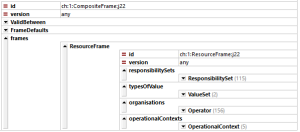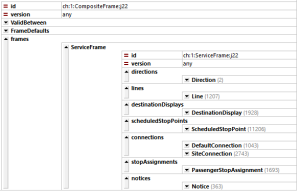NeTEx describes timetables and topologies. The entire public transport timetable can be found on opentransportdata.swiss in this format: https://data.opentransportdata.swiss/en/dataset/timetablenetex_2024.
There is a separate data set for on-demand traffic.
Technical description
CEN NeTEx is a European standard for networks, stops and timetables. In addition to HRDF and GTFS, all Swiss public transport data is also made available as NeTEx.
The export takes place weekly under: Timetable 2024 (NeTEx) – Dataset | Open data platform mobility Switzerland (opentransportdata.swiss)
Technical aspects
The current XSD is maintained in a github.
A profile (German only) applies to Switzerland. I.e. a restricted version of the standard. As the profile is based on “Calls”, it is possible that we will also provide a NeTEx version in the European profile (EPIP) and/or VDV 462.
For on-demand transport, the specialised concept (German only) and the technical concept (German only) of SKI+ can be found at öv-info.ch (German only).
Export
The export includes all public transport in Switzerland for the respective timetable year. It is split: Timetable 2024 (NeTEx) – Dataset | Open data platform mobility Switzerland (opentransportdata.swiss) (last year’s version: Timetable 2023 (NeTEx) – Dataset | Open data platform mobility Switzerland (opentransportdata.swiss)).
Reference will also be made to the Swiss profile (German only).
Due to the amount of data, a NeTEx export file can become very large. Values over 4 GB can occur. The processing of such files requires special tools, which usually have high licence fees. For this reason, the split NeTEx export is available.
The allocation is based on several aspects:
- By frames.
- The TimetableFrame is split again due to its size.
- An auxiliary file in .csv format is written to the split files. It provides an overview of where (in which file) data can be found.
The structure of the NeTEx delivery with its files is described here. For NeTEx per se, please refer to the Swiss profile (German only).
File names
The content should be clearly identifiable from the file names.
|
1 |
Example: "TEST_NETEX_TT_1.09_CHE_SKI_2022_SNCF_COMMON_1_1_202112101712.xml" |
| PosNr. | Format, content | Values | Description | Example |
| 1 | IT environment | DEV, TEST, INT, PROD | Describes the technical environment from which the file was produced: DEV : from development environment TEST ; from test environment INT from integration environment PROD from production environment TRAIN from training environment |
s. Werte |
| 2 | Format, content | NETEX_TT | Describes the format (NETEX) and the content (TimeTable) | s. Werte |
| 3 | Version | Number of the version of the NeTEx .xsd schema | 1.09, 1.10 | |
| 4 | Country | CHE | ISO code of the country in which the file was produced | s. Werte |
| 5 | Provider | SKI | Name of the organisation producing the file | s. Werte |
| 6 | FP period | Timetable period. | 2022, 2023 | |
| 7 | Name of export | Name of the export. Defines the technical scope of the timetable data | SNCF, OEV-SCHWEIZ | |
| 8 | Frame | Name of the frame to which the export data is assigned | SITE, TIMETABLE | |
| 9 | Number | Number of the file of a specific frame | 1, 2 | |
| 10 | Total | Number of files of the identical frame | 1, 120 | |
| 11 | Date, time | Date and time of production of the file Format : YYYYMMDDHHMM |
202101252254 25 Januar 2021 um 22:24 |
Files
The following files can be created:
| The RESOURCE file contains all elements of the ResourceFrame.
Examples: Operator. |
 |
| The SERVICE file contains all elements of the ServiceFrame.
Examples: Line, directions, walking times. |
 |
| The SERVICECALENDAR file contains the validity of the exported timetable (= timetable period) in the form of the ServiceCalendar and the day types (DayTypes), which in turn are assigned to various elements.
Examples: Validity of a journey. |
 |
| The SITE file contains all stops, areas, edges and locations that appear in the export.
Footpath routing within stops could also be exported here later in the form of PathLinks. |
 |
| The TIMETABLE file only contains journeys (vehicleJourneys) and train numbers (TrainNumbers).
Complex planning elements are moved from this file to the COMMON file. Train numbers are not moved from the TIMETABLE file to the COMMON file for readability reasons. |
 |
| The COMMON file only contains the TimetableFrame. Whereby no journeys are included here. These can be found in the TIMETABLE file.
They are separated because the TimetableFrame contains elements that sometimes have references to many different TimetableFrames. (e.g. TypeofService and ServiceFaciltiySet) In addition, incoming and outgoing journeys of an InterchangeRule are rarely found in the same TIMETABLE file. The division of the TimetableFrame therefore avoids redundancy. |
 |
The help file Readme
The file makes it possible to find specific data in the files. The attributes are
- Filename (name of the NeTEx file)
- Line (the line)
- Operator (company)
- Operator code (code of the company)
- ProductCode (type of means of transport)
Further information
- Validation of NeTEx files in the EU profile: https://greenlight.itxpt.eu/